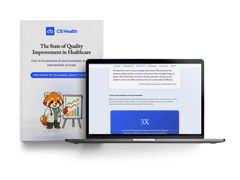
Impact of Health Information Technology on Patient Safety
I was recently part of a team that implemented a patient medication checking system at a major West Coast hospital. It was supposed to be a giant leap forward in safety technology, but what we found was shocking.
The hospital assured us they met all the requirements, but their barcodes wouldn't scan properly. Our system caught over 200 potentially deadly medication errors in the first week. The paperwork was a nightmare, but thankfully, we found all incorrect prescriptions before they reached any patients. It was a close call, though.
My experience with the hospital underscores a critical reality in health IT: even the most promising software can only be effective with proper implementation. That's why we'll look into how you can do it successfully to ensure patient safety.
Meet the Expert
Mical DeBrow is an accomplished healthcare leader and clinician with extensive expertise spanning pharma, healthcare payers and providers, and healthcare information technology.

Examples of Health IT Systems and Tools for Enhanced Patient Safety
Health IT encompasses a wide range of software applications and tools. They can improve the delivery and management of healthcare knowledge, directly impacting patient safety.
These include:
- Electronic Health Records (EHR): Secure digital systems for storing and managing a patient's medical history, medications, allergies, and other important health information. EHRs improve access to information for authorized healthcare providers, allowing for better-coordinated care.
- Computerized Physician Order Entry (CPOE): Electronic systems that allow doctors to directly order medications and tests within the EHR. CPOE reduces errors by eliminating handwritten orders and improving medication safety.
- Clinical Decision Support Systems (CDSS): Software programs that provide doctors with real-time information and recommendations based on a patient's medical history and condition. CDSS helps doctors make more informed decisions about diagnosis and treatment.
- Workflow Management Systems: Software tools designed to improve efficiency within healthcare organizations by automating tasks and streamlining processes. Workflow management systems can help reduce administrative burden and allow staff to focus more on patient care.
- Telemedicine Platforms: Technologies that enable doctors to consult with patients remotely using video conferencing or other digital tools. Telemedicine can increase access to healthcare, especially in underserved areas, and improve patient safety by allowing quicker consultations.
- Patient Engagement Tools: Mobile apps or online platforms that empower patients to actively participate in their care. These tools allow patients to view their medical records, schedule appointments, and communicate directly with their doctors, leading to better communication.

Quickly find exactly what you need
Always locally vetted and up to date
Streamline communications and support teamwork
Health IT Features That Can Improve Safety
1. Smart Error Handling
Error handling in Health IT systems can significantly improve patient safety. When a system warns you of a potential issue-like a medication dosage-you can intervene and prevent harm.
A hospital system on the East Coast implemented a medication-checking system, and they called me to train the night shift for a week. I identified over 400 medication errors. There were apparent issues-either improper equipment use or pharmaceutical problems. The culprit turned out to be a lack of education.
Note: The clinicians eventually became comfortable using the equipment and understood how it supported their work and documentation processes, but achieving this improvement required significant effort.
» Learn how to implement knowledge management effectively
2. Real-Time Access to Information
Previously, getting information from other departments was a time-consuming process. Now, I can instantly access data from labs, radiology, and even pharmacies.
Faster access ensures a quicker response time to anything wrong and helps confirm that things are going right. Having all this data at my fingertips enables me to manage better patient outcomes.
Many electronic health systems now include a decision support component. While the authority should rightly stay with the clinician, these tools provide invaluable help by offering real-time data and insights, ultimately improving patient safety.
Our latest webinar covers how AI can fuel these insights and lead to smarter, faster decisions.
» Automate your workflows to improve staff efficiency
3. Alerts
For decades, alert fatigue has been a concern for patient safety due to the overwhelming number of alerts generated. Ideally, your system should be adaptable and allow adjustments based on a person's specific condition.
But, disabling alerts entirely or setting overly broad parameters renders the system useless. All too often, I see people simply ignoring alerts and silencing them. To be valuable, they need to be well-calibrated.
Note: Fortunately, we have some excellent tools at our disposal to achieve this. A machine interpretation of an online electrocardiogram can be just as valuable as a traditional 12-lead EKG with manual caliper measurements.
4. Data Safety
Cloud storage can be a secure and private option for healthcare data, provided the proper infrastructure is in place. My experience in cybersecurity solidified my belief in the importance of robust security.
Recent events-like the cyberattacks on major healthcare organizations in the US-show the consequences of data breaches. Hundreds of thousands of people are affected, with patients unable to access prescriptions and employees facing delayed paychecks.
These breaches ultimately trickle down, impacting everyone involved. But healthcare systems can significantly improve their data security posture with proper safeguards like compliance with regulations and a deep understanding of cyber threats.
5. AI-Driven Systems for Patient Safety
The future of healthcare hinges on developing AI tools that empower clinicians rather than replace them. Machine learning and a comprehensive understanding of AI's potential are vital to improving patient outcomes.
Plus, robust AI-powered systems can significantly address healthcare worker turnover by providing better support. Imagine an EHR seamlessly integrating with clinician-patient interaction, delivering real-time data and insights, not abstract information. This is the future we should be striving for.
» Be at the forefront of innovation in patient care by using AI
Saving Lives in Healthcare: It's Not Just About the Tech
The close call I experienced highlights a critical need for a multi-pronged approach to patient safety in Health IT. Firstly, robust technology with proper implementation is essential.
Secondly, a well-structured onboarding helps the staff understand the system's capabilities and limitations. Finally, ongoing vigilance and adaptation are necessary to maintain a safe environment. By prioritizing these aspects, we can ensure that Health IT fulfills its promise of improving healthcare delivery and ensuring patient safety.
C8 Health's features, like automatic notifications for updated guidance and in-app content editing, support the need for ongoing vigilance and adaptation. With updates, healthcare teams are constantly working with the latest information.



